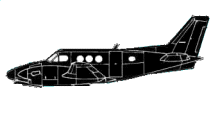
ASN Wikibase Occurrence # 289279
This information is added by users of ASN. Neither ASN nor the Flight Safety Foundation are responsible for the completeness or correctness of this information.
If you feel this information is incomplete or incorrect, you can submit corrected information.
| Date: | Friday 27 May 2011 |
| Time: | 14:15 LT |
| Type: |  Beechcraft C90 |
| Owner/operator: | Lp Aviation LLC |
| Registration: | N291CC |
| MSN: | LJ-728 |
| Year of manufacture: | 1977 |
| Total airframe hrs: | 10423 hours |
| Engine model: | P&W Canada PT6A-135A |
| Fatalities: | Fatalities: 0 / Occupants: 5 |
| Aircraft damage: | Substantial |
| Category: | Accident |
| Location: | Camden, South Carolina -
 United States of America United States of America
|
| Phase: | En route |
| Nature: | Private |
| Departure airport: | Charleston International Airport, SC (CHS/KCHS) |
| Newark Heath Airport, OH (KVTA) | |
| Investigating agency: | NTSB |
| Confidence Rating: |
The pilot obtained weather information via the internet before the flight. The information he obtained included advisories for convective activity and scattered thunderstorms along the intended northwesterly route of flight. The pilot reported that the takeoff and the climb to cruise altitude were "normal," with intermittent periods of light turbulence. About 100 miles northwest of the departure airport, the pilot observed weather ahead on the airplane's on-board weather radar and requested from the en route air traffic controller a 45-degree westerly course deviation. A course deviation was granted, but because of a potential conflict with a climbing airplane, the pilot was instructed to turn no more than 30 degrees west of his previously established heading. After turning the airplane 30 degrees, the pilot determined that he would need an additional 30- to 45-degree course deviation to avoid weather ahead. The pilot made at least two additional attempts to contact the controller, but received no response. Postaccident review of air traffic control recordings indicates that the pilot's transmissions were likely blocked, as one of them was made while another pilot was transmitting and the other was made while the controller was speaking to yet another pilot. The pilot made an additional course deviation, and the airplane encountered moderate to severe turbulence lasting about 2 minutes; however, the airplane performed normally after the turbulence encounter and the pilot continued to the destination airport, landing without further incident. Subsequent examination of the airplane revealed substantial damage to the wing spar, likely due to the turbulence encounter.
The airplane was equipped with a next generation radar receiver, weather radar, and a lightning strike indicator. The pilot was thus likely aware of areas of significant weather ahead of him, as well as the less significant weather to the northeast and south well before the encounter, and he was definitely aware of the clear weather through which he had just flown. Nonetheless, the pilot continued to fly toward his destination, and toward the significant weather, which resulted in the airplane's encounter with the turbulence.
Probable Cause: The pilot's in-flight decision to continue toward his destination, through known significant weather, when safer alternatives were available.
Accident investigation:
 |
|
Sources:
NTSB ERA11LA330
Location
Revision history:
| Date/time | Contributor | Updates |
|---|---|---|
| 05-Oct-2022 11:56 | ASN Update Bot | Added |
Corrections or additions? ... Edit this accident description
The Aviation Safety Network is an exclusive service provided by:


 ©2024 Flight Safety Foundation
©2024 Flight Safety Foundation